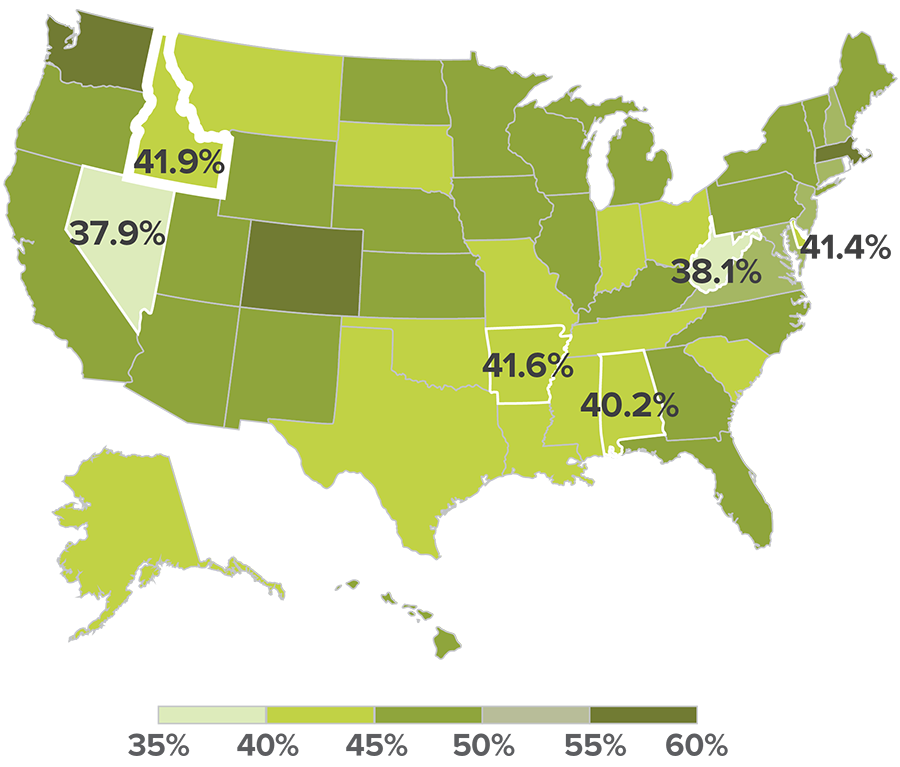Student Achievement
Idaho begins testing children when they enter kindergarten and continues testing them into high school.
That was the habit until 2020 — a year when most tests were canceled after schools shut their doors to slow a worldwide pandemic. Schools had to bounce between in-person learning and online instruction, so expectations were lowered and some learning just didn’t happen.
New President Joe Biden says educators nationwide must resume giving standardized tests this spring because it’s urgent to understand the impact of COVID-19 on learning.
But his administration relieved the pressure associated with high-stakes testing by declaring schools won’t be held accountable for the results. He also said states could give shorter, remote or delayed versions of the exams.
Idaho plans to have some 170,000 students take the Idaho Standards Achievement Test this spring, before May 28, in traditional fashion, except this year’s version of the ISAT will be 30 to 40 minutes shorter. It’s expected the results will be troubling, but important measures to quantify learning loss.
“You can’t fix a problem you don’t understand,” State Board of Education member Kurt Liebich said to EdNews’ senior reporter Kevin Richert.
State education leaders say they’ll use the test scores to help direct how to spend federal stimulus dollars, targeting the money toward training teachers and helping kids catch up.
Idaho’s youngest children — those in kindergarten, first, second and third grades — will take the Idaho Reading Indicator this spring. These same children took the reading tests in the fall, and the fall results will be compared against the upcoming spring results for growth. Again, educators are expecting troubling scores.
“It’s likely that there are going to be gaps everywhere,” Liebich said.
Scores
Spring Reading Scores
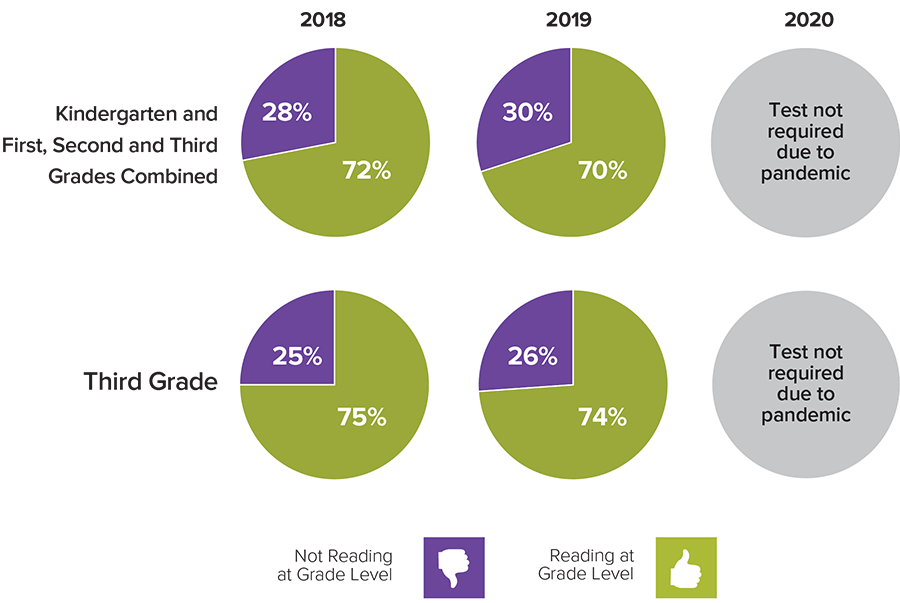
Idaho’s Best Fall of 2020 Reading Scores
(percentage reading at grade level)

Fall Reading Scores

The 2020 spring reading tests were canceled due to the spread of coronavirus. Children returned to school in the fall of 2020 and most in kindergarten, first, second and third grades took the twice-annual exams. Scores were dismal and fell well below the previous fall performances.
Idaho’s Standardized Test
ISAT English Language Arts

ISAT Math

ISAT Science

Schools must administer federally required standardized tests this year, according to President Joe Biden. His administration is ordering the return of testing — tests were canceled in 2020 because of the pandemic. But in 2021, the administration has promised schools won’t be held accountable for the results — and states could give shorter, remote or delayed versions of the exams.
Idaho plans to have some 170,000 students take the Idaho Standards Achievement Test. They will take the test in April and May, and it will be 30 to 40 minutes shorter. Teachers will eventually get data on students who haven’t been tested in two years.
Before the pandemic, Idaho was starting to make gains in test scores in English Language Arts and Math. Results slipped in Science.
This spring’s assessments likely won’t show growth but will provide a snapshot into student proficiency.
The ISAT is delivered to all students in grades three-eight and grade 10. Federal law requires at least 95% of students be given the exam. Idaho has seen no significant growth on its standardized test results. Students did not take the tests in 2020. Those tests were canceled due to the pandemic.
National College Entrance Exam: SAT
Graduating Class of 2020
Idaho’s class of 2020 was less prepared for college and the workforce than graduates from the previous year, according to results from the SAT.
SAT data released by The College Board shows Idaho’s most recent group of seniors scored lower overall and met fewer college readiness benchmarks than the class of 2019. The results mark the third year in a row of declining performance on the test.
Seniors graduating in 2020 had an average composite score of 984 out of 1600 possible points on the SAT. That’s nine points down from the year before. The dip follows a national trend. The U.S. average was 1051 points in 2020, down eight points from the 2019 average.
The Idaho test results don’t show signs of improvement as Idaho struggles to increase the number of students continuing their education beyond high school.
Only 57% of 2020 graduates met the college and career readiness benchmark in reading and writing, compared with 60% in 2019.
Some 34% of 2020 graduates met the math benchmark.
About 32% of students met benchmarks in both math and language sections, down from 33% the year before. And 40% of students met neither benchmark.
The SAT is an important test to education leaders as they require all students to take a college placement test in order to graduate from high school. Nearly 100% of the 2020 seniors took the SAT at some point in their high school career. Taxpayers invest about $1 million a year to pay for all juniors to take the test.
Students are considered college- and career-ready when their SAT scores meet both the math (530) and the evidence-based reading and writing (480) benchmarks. Most Idaho students fail to meet both benchmarks.
SAT Composite Scores
Highest Possible Score: 1600
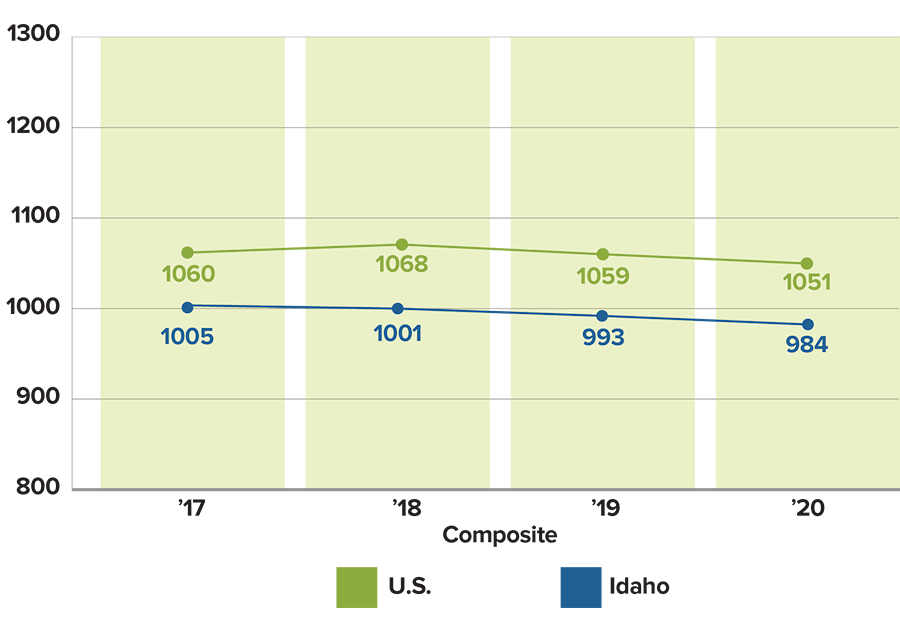
SAT Composite Scores Compared to Idaho’s Postsecondary Go-On Rate
Idaho’s scores on the SAT have dropped over the years as has the number of high school graduates who chose to continue their education.
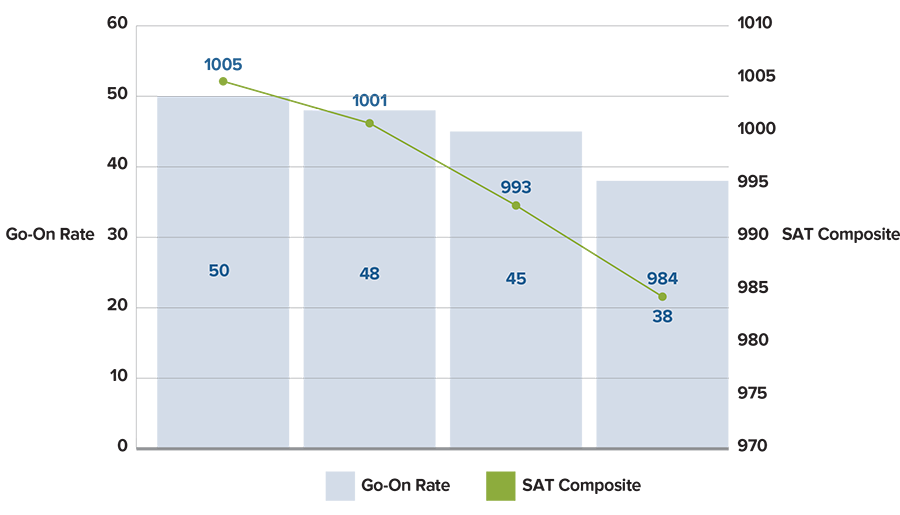
Graduation Rates
Idaho’s High School Graduation Rate Shows Improvement
Idaho’s high school graduation rate increased in 2020 and improvements were seen across the board, including increases for Hispanic/Latino students and students with disabilities.
For the class of 2020, the four-year graduation rate was 82.1%, compared with 80.7% the previous year. Some graduation requirements were suspended during the pandemic, such as senior projects.
For Hispanic/Latino students, the graduation rate increased by nearly 2 percentage points to 75.7%.
Graduation rates for other at-risk groups increased as well:
- For students with disabilities, the graduation rate was 59.0%, up 3 percentage points.
- For migrant students, the graduation rate was 70.3%, up 6 percentage points.
The graduation rate for English Language Learners was 64.6%, down nearly 10 percentage points.
Overall, Idaho’s high school graduation rate fell well short of the state’s goal. For the class of 2020, the state’s goal was 89.9%.
Graduation rates are determined by the number of students who graduate in four years divided by the number of students who started ninth grade. Students who transfer and enroll in another school are not counted.
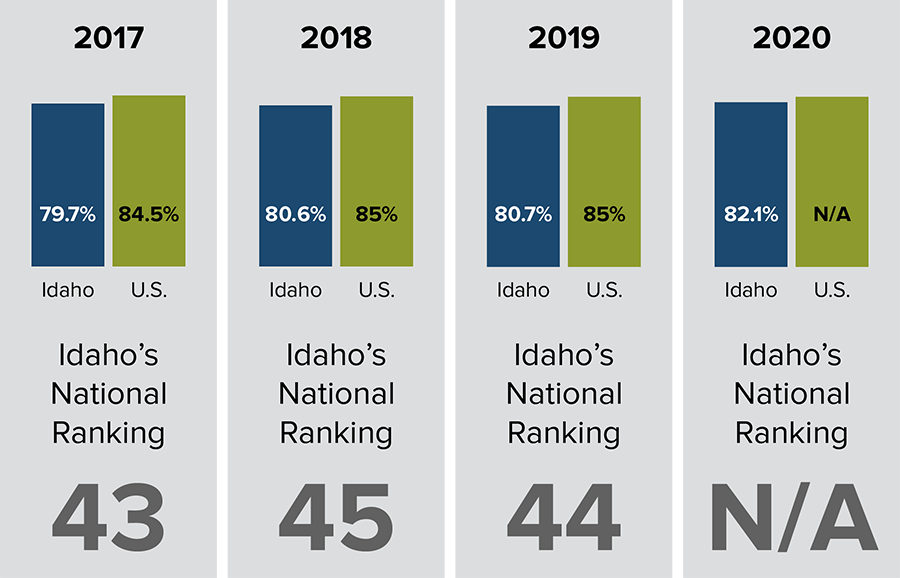
High Schools with 100% Graduation Rate, 2020
- American Heritage
- Basin Alternative
- Camas County
- Cambridge
- Carey Public
- Clark County
- Culdesac
- Idaho Fine Arts Academy
- Kendrick
- Kootenai
- Leadore
- Liberty Charter
- Meridian Technical Charter
- Mullan
- Murtaugh
- Nezperce
- North Idaho Stem Charter
- North Star Charter
- Oakley
- Rockland
- Vision Charter
- West Jefferson
Grad Rates for Idaho’s 10 Largest Districts
| District | Graduation Rate |
|---|---|
| Coeur d'Alene | 91.5% |
| Pocatello | 91.1% |
| Oneida | 91% |
| Bonneville | 89.3% |
| West Ada | 87.5% |
| Vallivue | 86.5% |
| Twin Falls | 80.4% |
| Boise Independent | 80% |
| Nampa | 79.9% |
| Idaho Falls | 78.4% |
Go-on Rates
Idaho's Go-On Rate Drops Amid Pandemic
Only 38% of Idaho’s 2020 high school graduates continued their education in the fall. That translates into a 7 percentage point drop in the state’s “immediate,” spring-to-fall go-on rate, and pencils out to a difference of about 1,400 students.
When Idaho’s “Go-On Rates” fell sharply last fall, they decreased in every demographic group. These demographics are important because Idaho’s Hispanic and American Indian college graduation numbers are among the worst in the nation.
Across the board, the go-on rates are discouraging.
| Ethnicity | Class of 2019 | Class of 2020 |
|---|---|---|
| White | 46% | 39% |
| Hispanic | 40% | 34% |
| American Indian | 37% | 35% |
| Black | 50% | 44% |
| Asian | 61% | 59% |
| Hawaiian/other Pacific Islander | 36% | 22% |
| Multiracial | 49% | 41% |
The go-on rate is the percentage of students entering a post-secondary education program in the fall after high school graduation. Young adults who do not go on to some form of higher education, and instead go on religious missions or join the military, are not counted.
Idaho’s Go-On Rate Compared with U.S. Go- On Rate

Idaho’s Top Go-on high schools:
| School | Go-On Rate |
|---|---|
| Prairie (Cottonwood School District) | 86.4% |
| Coeur d’Alene Charter Academy | 80.9% |
| Genesee (Genesee School District) | 78.6% |
| North Star Charter (Eagle) | 77.3% |
| Meridian Medical Arts Charter | 74.3% |
| Cambridge (Cambridge School District) | 71.4% |
| Liberty Charter (Nampa School District) | 66.7% |
| Renaissance High School (West Ada School District) | 61.5% |
Again in 2020, alternative high schools and virtual charters account for the state’s lowest go-on rates. This year, Idaho had 14 high schools with a 0% go-on rate.
Degree Attainment
College Degree or Certificate Attainment Data Has Improved
About 44% of Idaho’s young adults hold a college degree or professional certificate, according to newly released U.S. Census Bureau numbers.
Idaho’s postsecondary completion rate had been stagnant for three straight years before the slight uptick in the past two years.
The numbers haven’t moved much — despite two gubernatorial task forces, more than $133 million in new state spending and an ongoing drive from education, political and business leaders.
Idaho leaders want 60% of the state’s 25- to 34-year-olds to obtain a degree or certificate. They say high school graduates need to continue their education in order to prepare for a modern job market, and help Idaho compete in a changing economy.
Idaho’s Degree Attainment Rate Compared with U.S. Degree Attainment Rate
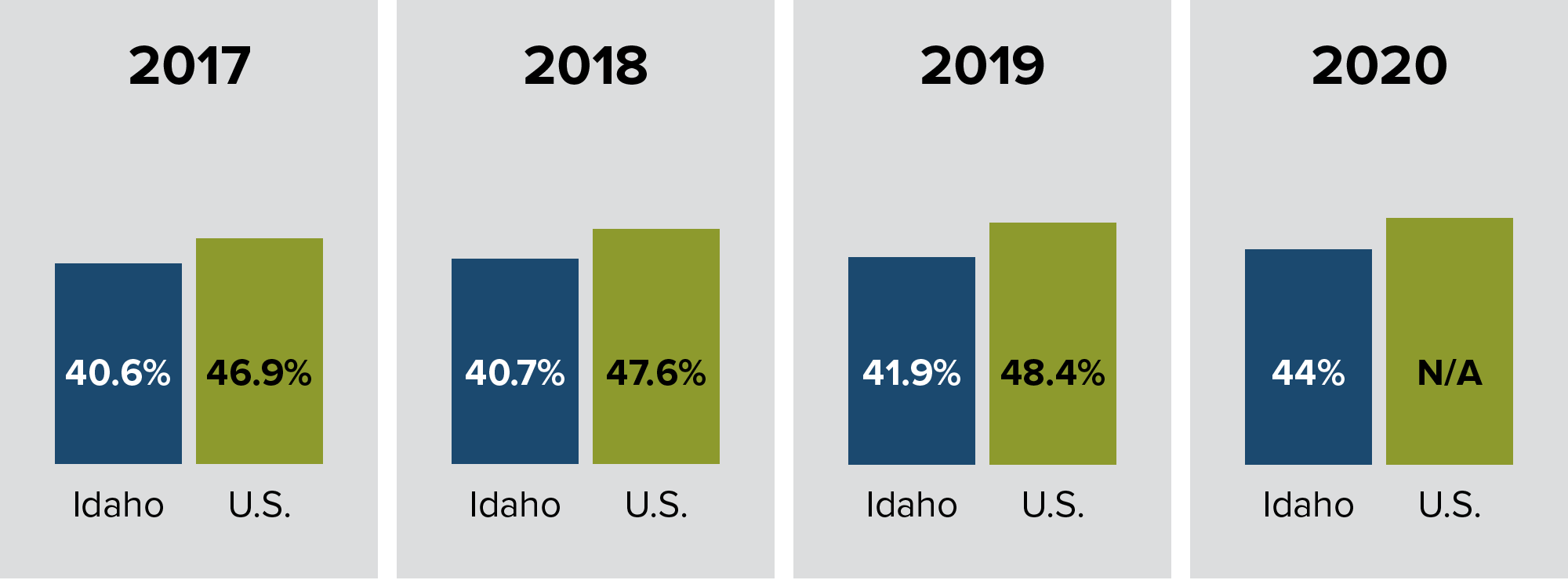
National Lumina Report Puts Idaho Near the Bottom
The Lumina Foundation, an Indianapolis, Indianabased foundation, is pushing a national 60% goal, with a 2025 target date that mirrors Idaho’s goal. Lumina tracks Idaho’s college attainment rate at about 41.9% because it considers all adults. Idaho’s goal is focused only on 25- to 34- year-olds. Nationally, Lumina’s postsecondary completion rate comes in at 48.4%. Idaho’s 41.9% rate is good enough to beat only five other states: Alabama, Arkansas, Delaware, Nevada and West Virginia.
